Pecharsky V.K., Zavalij P.Y. Fundamentals of Powder Diffraction and Structural Characterization of Materials
Подождите немного. Документ загружается.

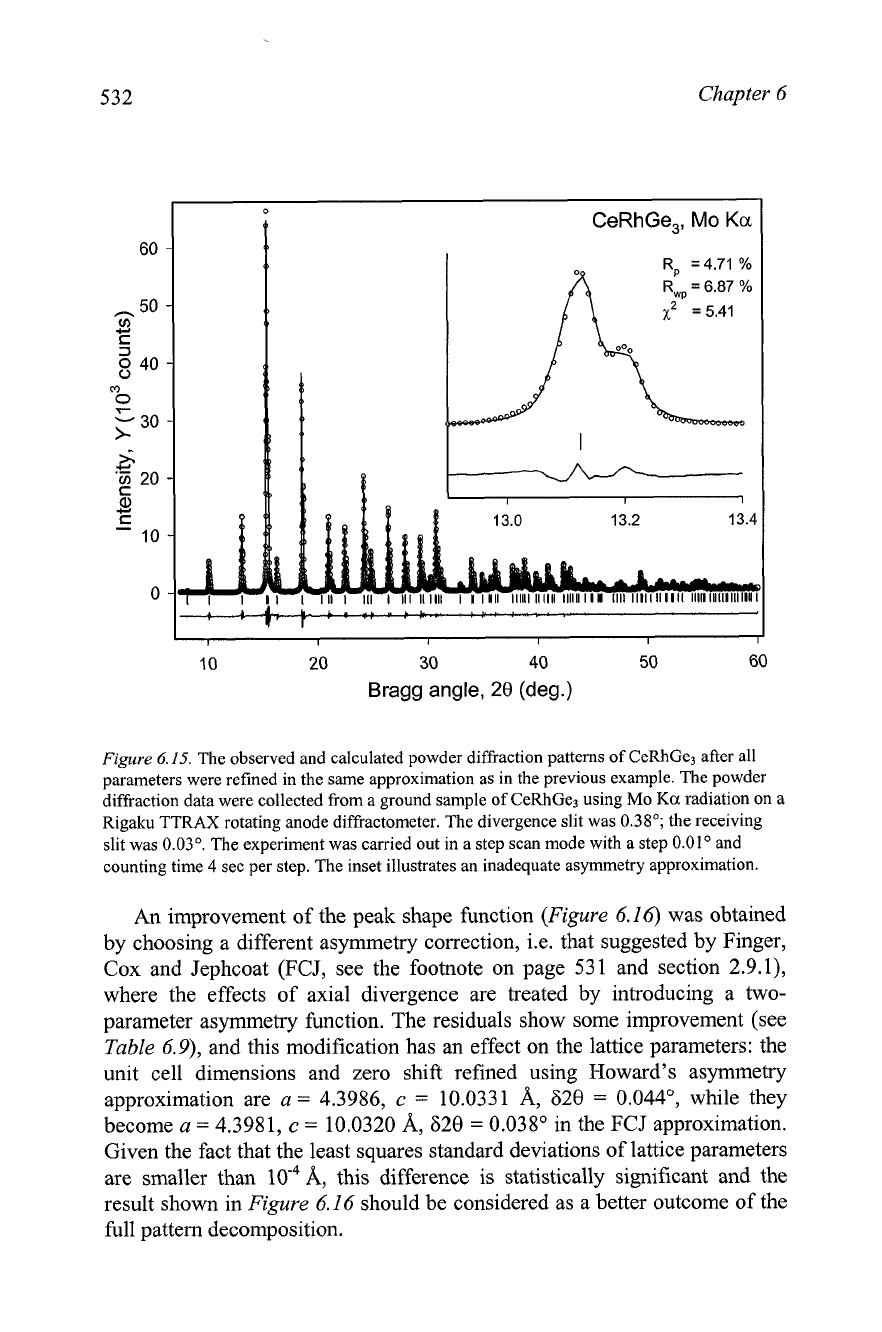
Chapter
6
10
20
30
40
50
60
Bragg angle,
28
(deg.)
Figure
6.15.
The observed and calculated powder diffraction patterns of CeRhGe3 after all
parameters were refined in the same approximation as in the previous example. The powder
diffraction data were collected from a ground sample of CeRhGe3 using Mo
Ka
radiation on a
Rigaku
TTRAX
rotating anode diffractometer. The divergence slit was 0.38'; the receiving
slit was 0.03'. The experiment was carried out in a step scan mode with a step 0.01' and
counting time
4
sec per step. The inset illustrates an inadequate asymmetry approximation.
An
improvement of the peak shape function
(Figure
6.16)
was obtained
by choosing a different asymmetry correction, i.e. that suggested by Finger,
Cox and Jephcoat (FCJ, see the footnote on page 531 and section 2.9.1),
where the effects of axial divergence are treated by introducing a two-
parameter asymmetry function. The residuals show some improvement (see
Table
6.9), and this modification has an effect on the lattice parameters: the
unit cell dimensions and zero shift refined using Howard's asymmetry
approximation are
a
=
4.3986,
c
=
10.0331
A,
628
=
0.044", while they
become
a
=
4.3981,
c
=
10.0320
A,
628
=
0.038" in the FCJ approximation.
Given the fact that the least squares standard deviations of lattice parameters
are smaller than
A,
this difference is statistically significant and the
result shown in
Figure
6.16
should be considered as a better outcome of the
full pattern decomposition.

Crystal structure solution
533
Bragg angle,
29
(deg.)
Figure
6.16.
The observed and calculated powder diffraction patterns of CeRhGe3 after
refinement of all parameters with an asymmetry correction in the Finger, Cox and Jephcoat
approximation. The inset illustrates an adequately treated asymmetry (compare with the inset
in
Figure
6.15).
Table
6.10.
The list of Bragg reflections with their corresponding observed structure factors
squared determined after
L;
Bail's full pattern decomposition of the x-ray powder diffraction
pattern of CeRhGe,.
h
k
1
~l~~~~l~
h
k
1
IF^^^^^
~l~~~~l~
00 2 13
Oa
23
7
146
1

534
Chapter
6
13
8
46
0 15
8
101 1
"
Some of the errors are listed as zeros because of automatic rounding to integers.
Just as in the previous example, CeRhGes is an intermetallic compound
and it makes sense to assume the highest symmetry space group
-
I4lmmm
-
as a first attempt to solve the crystal structure. Once again, we are looking
for a total of
10
atoms, 2 Ce, 2
Rh
and
6
Ge; Ce is the strongest scattering
atom
(58
electrons), while Ge is the weakest (32 electrons). Considering the
simplicity of the unit cell and the presence of only two heavy atoms (Ce), the
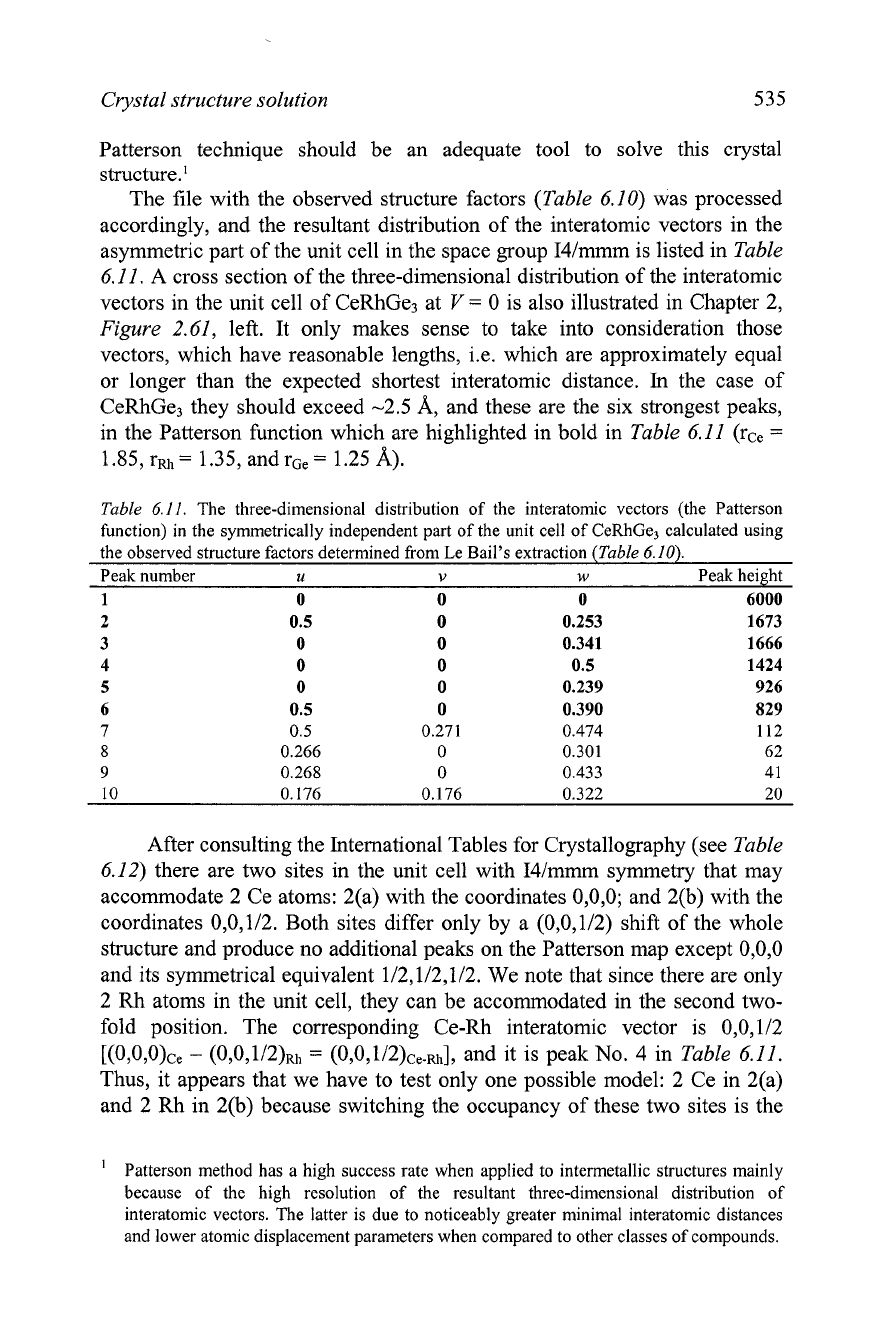
Crystal structure solution 535
Patterson technique should be an adequate tool to solve this crystal
structure.
'
The file with the observed structure factors (Table 6.10) was processed
accordingly, and the resultant distribution of the interatomic vectors in the
asymmetric part of the unit cell in the space group I4lmmm is listed in Table
6.11. A cross section of the three-dimensional distribution of the interatomic
vectors in the unit cell of
CeRhGe3 at
V
=
0 is also illustrated in Chapter 2,
Figure 2.61, left. It only makes sense to take into consideration those
vectors, which have reasonable lengths, i.e. which are approximately equal
or longer than the expected shortest interatomic distance. In the case of
CeRhGe3 they should exceed -2.5 A, and these are the six strongest peaks,
in the Patterson function which are highlighted in bold in Table 6.11
(rCe
=
1.85, r~,
=
1.35, andrGe
=
1.25 A).
Table 6.11. The three-dimensional distribution of the interatomic vectors (the Patterson
function) in the symmetrically independent part of the unit cell of CeRhGe3 calculated using
the observed structure factors determined from Le Bail's extraction (Table 6.10).
Peak number
u
v
w
Peak height
1 0 0 0 6000
2 0.5 0 0.253 1673
3 0 0 0.341 1666
4
0
0 0.5 1424
5 0 0 0.239 926
6 0.5 0 0.390 829
7 0.5 0.271 0.474 112
8 0.266 0 0.301 62
9
0.268 0 0.433 41
10 0.176 0.176 0.322 20
After consulting the International Tables for Crystallography (see Table
6.12) there are two sites in the unit cell with I4/mmm symmetry that may
accommodate 2 Ce atoms: 2(a) with the coordinates 0,0,0; and 2(b) with the
coordinates
0,0,1/2. Both sites differ only by a (0,0,1/2) shift of the whole
structure and produce no additional peaks on the Patterson map except
0,0,0
and its symmetrical equivalent 1/2,1/2,1/2. We note that since there are only
2 Rh atoms in the unit cell, they can be accommodated in the second two-
fold position. The corresponding Ce-Rh interatomic vector is
0,0,1/2
[(O,O,O)ce
-
(0,0,1/2)Rh
=
(0,0,1/2)ce.Rh], and it is peak No. 4 in Table 6.11.
Thus, it appears that we have to test only one possible model: 2 Ce in 2(a)
and 2 Rh in 2(b) because switching the occupancy of these two sites is the
'
Patterson method has
a
high success rate when applied to intermetallic structures mainly
because of the high resolution of the resultant three-dimensional distribution of
interatomic vectors. The latter is due to noticeably greater minimal interatomic distances
and lower atomic displacement parameters when compared to other classes of compounds.
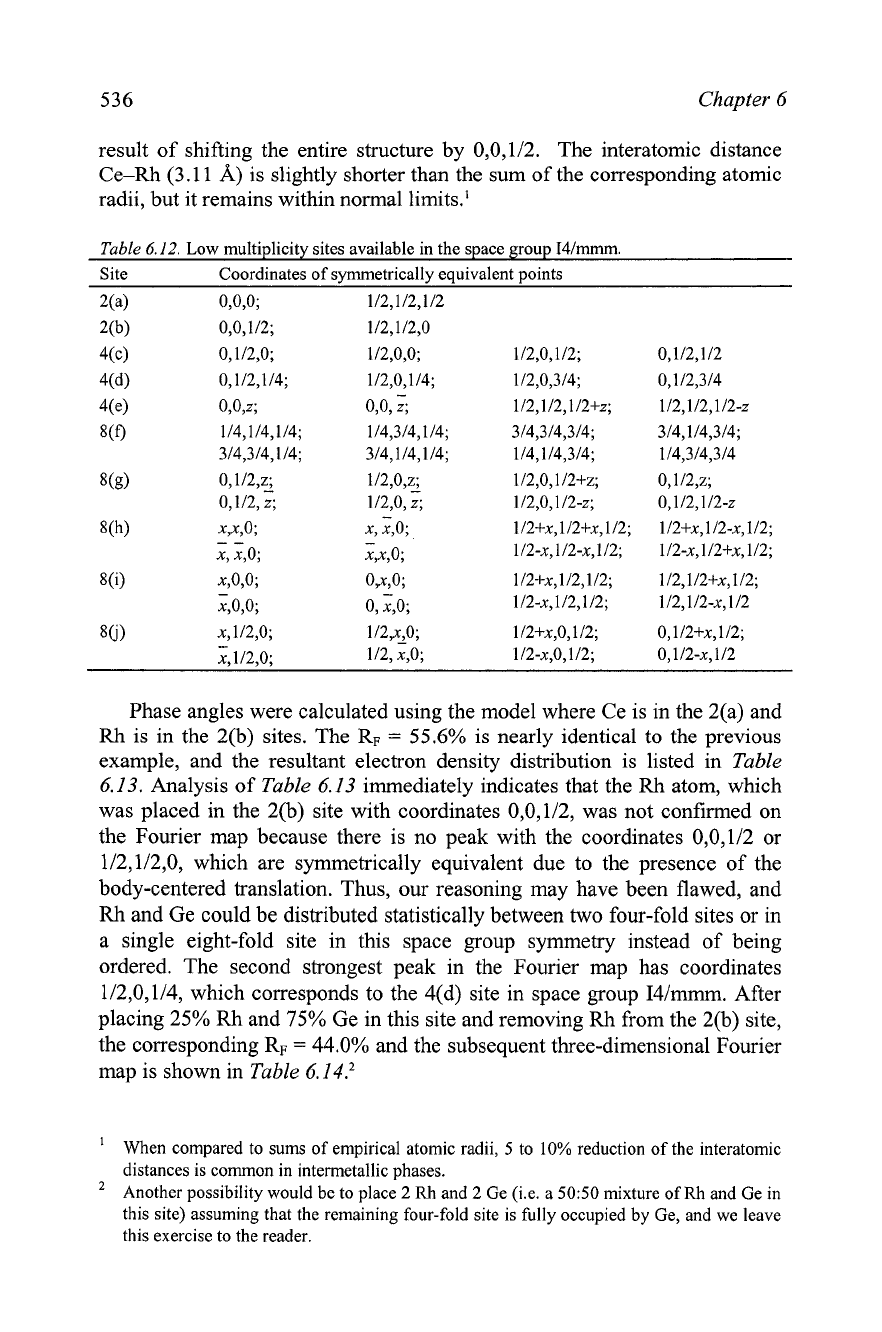
536
Chapter
6
result of shifting the entire structure by 0,0,1/2.
The interatomic distance
Ce-Rh (3.11
A)
is slightly shorter than the sum of the corresponding atomic
radii, but it remains within normal limits.'
Table
6.12.
Low multiplicity sites available in the space group
14lrnrnn-1.
Site
Coordinates of symmetrically equivalent points
Phase angles were calculated using the model where Ce is in the 2(a) and
Rh
is in the 2(b) sites. The
RF
=
55.6%
is nearly identical to the previous
example, and the resultant electron density distribution is listed in
Table
6.13.
Analysis of
Table
6.13
immediately indicates that the
Rh
atom, which
was placed in the 2(b) site with coordinates 0,0,1/2, was not confirmed on
the Fourier map because there is no peak with the coordinates 0,0,1/2 or
1/2,1/2,0, which are symmetrically equivalent due to the presence of the
body-centered translation. Thus, our reasoning may have been flawed, and
Rh
and Ge could be distributed statistically between two four-fold sites or in
a single eight-fold site in this space group symmetry instead of being
ordered. The second strongest peak in the Fourier map has coordinates
1/2,0,1/4, which corresponds to the 4(d) site in space group I4/mmm. After
placing
25%
Rh
and
75%
Ge in this site and removing
Rh
from the 2(b) site,
the corresponding
RF
=
44.0% and the subsequent three-dimensional Fourier
map is shown in
Table
6.1
4.2
When compared to sums of empirical atomic radii, 5 to 10% reduction of the interatomic
distances is common in intermetallic phases.
Another possibility would be to place
2
Rh
and
2
Ge (i.e. a 50:50 mixture of
Rh
and Ge in
this site) assuming that the remaining four-fold site is fully occupied by Ge, and we leave
this exercise to the reader.
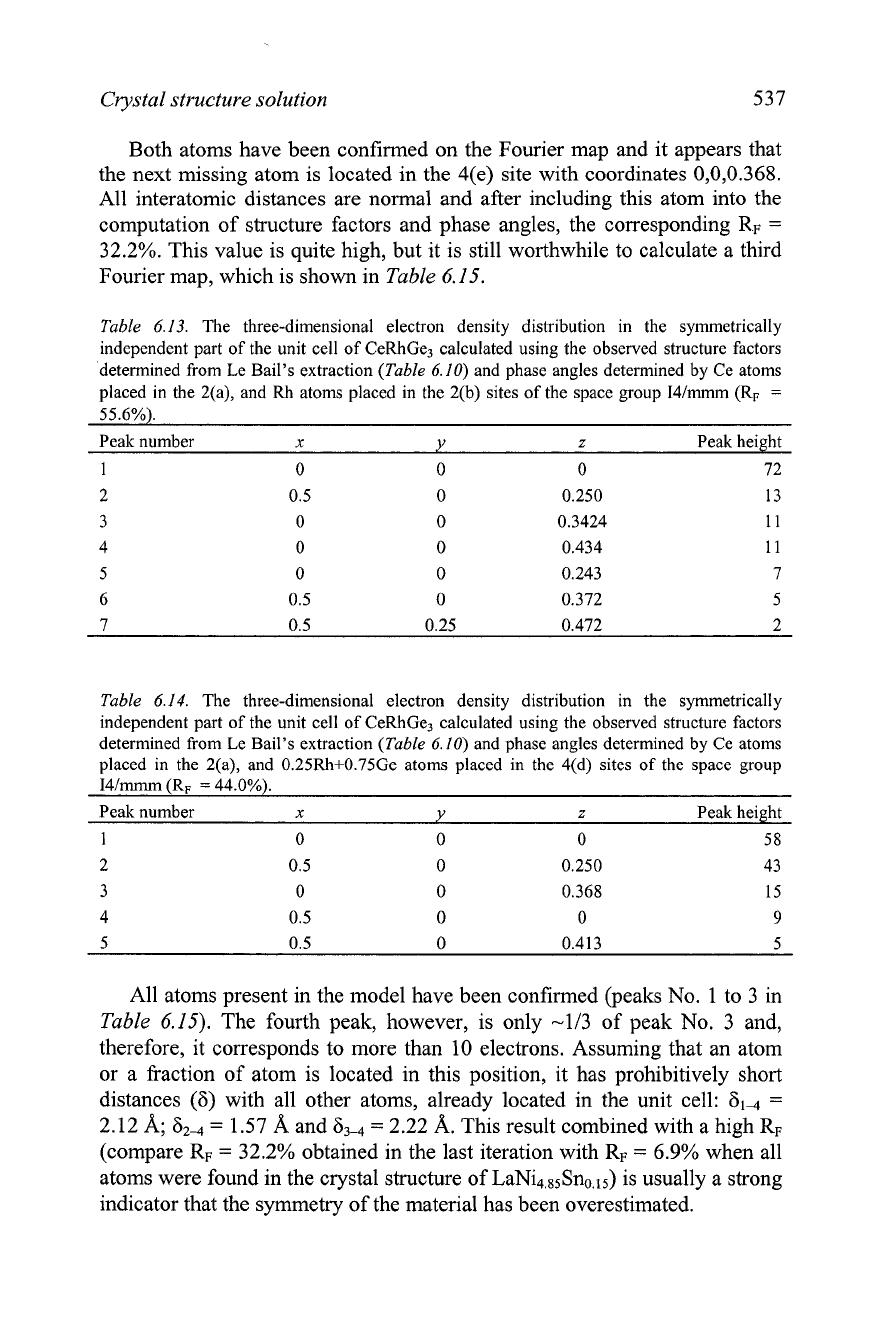
Crystal structure solution
537
Both atoms have been confirmed on the Fourier map and it appears that
the next missing atom is located in the 4(e) site with coordinates 0,0,0.368.
All
interatomic distances are normal and after including this atom into the
computation of structure factors and phase angles, the corresponding
RF
=
32.2%. This value is quite high, but it is still worthwhile to calculate a third
Fourier map, which is shown in
Table
6.15.
Table
6.13.
The three-dimensional electron density distribution in the symmetrically
independent part of the unit cell of CeRhGe3 calculated using the observed structure factors
determined from Le Bail's extraction
(Table
6.10)
and phase angles determined by Ce atoms
placed in the
2(a),
and
Rh
atoms placed in the
2(b)
sites of the space group
I4/mmm
(RF
=
55.6%).
Peak number
x
Y
z
Peak height
1
0 0 0 72
2
0.5 0 0.250 13
3
0
0 0.3424 11
4 0 0 0.434
11
5 0 0 0.243 7
6 0.5
0
0.372 5
7
0.5 0.25 0.472
2
Table
6.14.
The three-dimensional electron density distribution in the symmetrically
independent part of the unit cell of CeRhGe3 calculated using the observed structure factors
determined from Le Bail's extraction
(Table
6.10)
and phase angles determined
by
Ce atoms
placed in the 2(a), and
0.25Rh+0.75Ge
atoms placed in the
4(d)
sites of the space group
I4/mmm
(RF
=
44.0%).
Peak number
x
Y
z
Peak height
1
0
0
0 58
2
0.5 0 0.250 43
3
0 0 0.368 15
4
0.5 0 0
9
All atoms present in the model have been confirmed (peaks No.
1
to 3 in
Table
6.15). The fourth peak, however, is only -113 of peak No. 3 and,
therefore, it corresponds to more than 10 electrons. Assuming that an atom
or a fraction of atom is located in this position, it has prohibitively short
distances (6) with all other atoms, already located in the unit cell:
6i4
=
2.12
A;
62-4
=
1.57
A
and 63-4
=
2.22
A.
This result combined with a high
RF
(compare
RF
=
32.2% obtained in the last iteration with
RF
=
6.9%
when all
atoms were found in the crystal structure of LaNi4,s5Sno.15) is usually
a
strong
indicator that the symmetry of the material has been overestimated.

538
Chapter
6
Table
6.15.
The three-dimensional electron density distribution in the symmetrically
independent part of the unit cell of CeRhGe3 calculated using the observed structure factors
determined from Le Bail's extraction (Table
6.10)
and phase angles determined by Ce atoms
placed in the 2(a), and 0.25Rh+0.75Ge atoms placed in the 4(d) and
4(c)
[z
=
0.3681 sites of
the space group I4lmrnm
(RF
=
32.2%).
Peak number
x
Y
z Peak height
1 0 0 0 47
2 0 0 0.363 25
3 0.5 0 0.250 23
4 0 0 0.21 1 8
5
0 0 0.100
5
It is possible to use this model of the crystal structure and attempt
Rietveld refinement (as will be illustrated in Chapter
7),
but we will proceed
with testing other space groups from the list of
8
possible (14/mmm, 14rn2,
142m, I4mm, 1422, I4/m,
14
and 14). Analysis of space groups 14m2 and
142m indicates that available low-multiplicity sites are essentially identical
to those of the space group I4/mmm. When these two groups are tested as
described above, the resultant models are also quite suspicious.
The next space group on the list is I4mm (Table
6.16).
This group has no
fixed origin along the Z-axis: one available two fold site 2(a) has coordinates
0,0,z, and the only available 4-fold site has coordinates 1/2,0,z. We note that
there is no reason to recalculate the Patterson function, because its symmetry
remains
I41mmm. To ensure that we do not place any of the atoms
incorrectly we now position only 2 Ce atoms in the 2(a) site in this space
group. Because the origin along the Z-axis can be chosen arbitrarily in this
space group, it does not matter which
z-coordinate is chosen for Ce. After
placing 2 Ce in
2(a) with z
=
0.000, the RF is 42.6
%,
and the resultant
electron density distribution is shown in Table
6.17.
Table
6.16.
Low multiplicity sites available in the space group
I4mm.
Site
Coordinates of symmetrically equivalent points
2(a) o,o,z; 1/2,1/2,1/2+z
4(b) 0,112,z;
-
1/2,o,z; 1/2,0,1/2+z; 0,1/2,1/2+z
8(c)
XJA
-
-
xJ,z;
-
1/2+x, 112+x, 1/2+z; 112-x, 1/2+x, 1/2+z;
x, x,z; x, 42; 112-x, 112-x, 1 12+z; 1 12+x, 1 /2+x,
1
/2+z
8(d) x,o,z;
OAz;
1/2+x, 1/2,1/2+z; 112,1/2+x, 1 /2+z;
x,o,z;
0, x,z;
112-x, 1/2,1/2+z; 112,112-x, 1 /2+z;
There is no sharp reduction of peak heights between any pair of peaks in
Table
6.1 7
except after the first, and therefore, we proceed by adding just
one two fold-site for the next iteration. Choosing peak No.2 and assuming
that it is the next strongest scattering atom, i.e.
Rh,
the distance between this
peak and Ce atom in 2(a) with
z
=
0.000 is normal. The residual did not
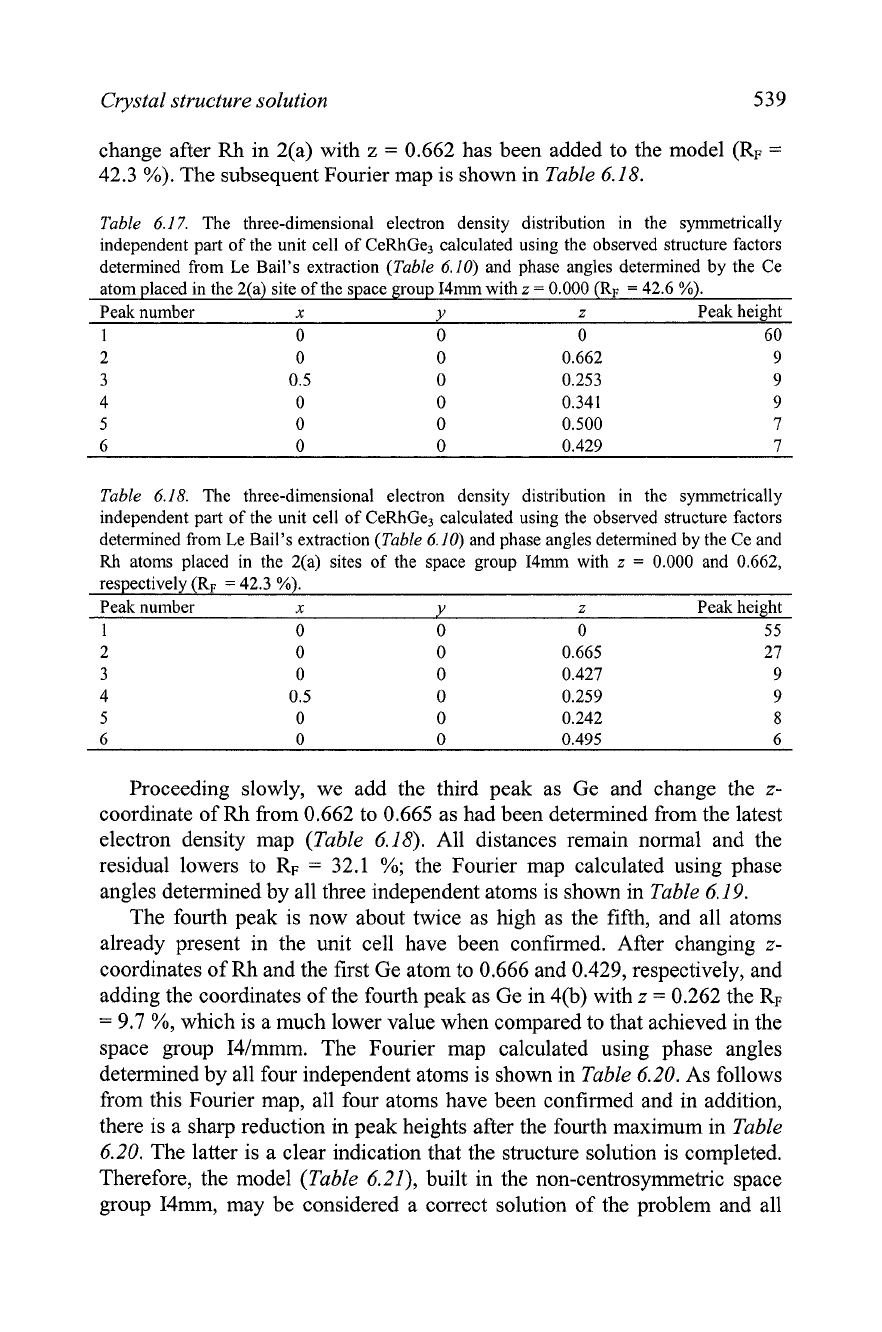
Crystal structure solution 539
change after
Rh
in 2(a) with
z
=
0.662 has been added to the model (RF
=
42.3
%).
The subsequent Fourier map is shown in Table 6.18.
Table
6.17. The three-dimensional electron density distribution in the symmetrically
independent part of the unit cell of CeRhGe3 calculated using the observed structure factors
determined from Le Bail's extraction
(Table
6.10) and phase angles determined by the Ce
atom placed in the 2(a) site of the space group I4mm with
z
=
0.000 (RF
=
42.6
%).
Peak number
x
Y
z
Peak height
1 0 0 0 60
2 0 0 0.662 9
3
0.5 0 0.253 9
4 0 0 0.341 9
5 0 0 0.500
7
6 0 0 0.429
7
Table
6.18. The three-dimensional electron density distribution in the symmetrically
independent part of the unit cell of CeRhGe3 calculated using the observed structure factors
determined from Le Bail's extraction
(Table
6.10) and phase angles determined by the Ce and
Rh atoms placed in the 2(a) sites of the space group I4mm with
z
=
0.000 and 0.662,
respectively (RF
=
42.3
%).
Peak number
x
Y
z
Peak height
1 0 0 0 5 5
2 0 0 0.665 27
3
0 0 0.427 9
4 0.5 0 0.259 9
5 0 0 0.242
8
6
0
0
0.495
6
Proceeding slowly, we add the third peak as Ge and change the
z-
coordinate of
Rh
from 0.662 to 0.665 as had been determined from the latest
electron density map (Table 6.18). All distances remain normal and the
residual lowers to
RF
=
32.1
%;
the Fourier map calculated using phase
angles determined by all three independent atoms is shown in Table 6.19.
The fourth peak is now about twice as high as the fifth, and all atoms
already present in the unit cell have been confirmed. After changing
z-
coordinates of
Rh
and the first Ge atom to 0.666 and 0.429, respectively, and
adding the coordinates of the fourth peak as Ge in 4(b) with
z
=
0.262 the
RF
=
9.7
%,
which is a much lower value when compared to that achieved in the
space group I4lmmm. The Fourier map calculated using phase angles
determined by all four independent atoms is shown in Table 6.20. As follows
from this Fourier map, all four atoms have been confirmed and in addition,
there is a sharp reduction in peak heights after the fourth maximum in Table
6.20. The latter is a clear indication that the structure solution is completed.
Therefore, the model (Table 6.21), built in the non-centrosymmetric space
group
I4mm, may be considered a correct solution of the problem and all

Chapter
6
structural parameters of CeRhGe3 should be finalized by Rietveld refinement
(see section
7.4).
Table 6.19. The three-dimensional electron density distribution in the symmetrically
independent part of the unit cell of CeRhGe, calculated using the observed structure factors
determined from Le Bail's extraction (Table 6.10) and phase angles determined by Ce in 2(a)
with
z
=
0.000,
Rh
in 2(a) with
z
=
0.665 and Ge in 2(a) with
z
=
0.427 in the space group
I4mm (RF
=
32.1
%).
Peak number
x
Y
z
Peak height
1
0 0 0 47
2 0 0 0.666 33
3 0 0 0.429 23
4
0.5 0 0.262 9
5 0.5 0 0.400 5
Table 6.20. The three-dimensional electron density distribution in the symmetrically
independent part of the unit cell of
CeRhGe, calculated using the observed structure factors
determined from Le Bail's extraction (Table 6.10) and phase angles determined by Ce in 2(a)
with
z
=
0.000, Rh in 2(a) with
z
=
0.666, Ge in 2(a) with
z
=
0.429 and Ge in 4(b) with
z
=
0.262 in the space group I4mm (RF
=
9.7%). See also Figure
2.59,
left, in Chapter 2, where
this Fourier map is visualized, although with a different selection of the origin of coordinates.
Peak number
x
Y
z
Peak height
1
0 0 0 42
2 0 0 0.665 32
3
0
0
0.428 22
4 0.5 0 0.265 20
5 0 0 0.173 2
6 0.25 0 0.700 2
Table 6.21. Coordinates of atoms in the unit cell of CeRhGe, as determined from x-ray
powder diffraction data in the space group symmetry
I4mm.
Atom
Site
x
Y
z
Ce
2(a)
0 0
0.000
Rh
2(a)
0
0 0.665
Ge 1
2(a) 0 0 0.428
Ge2 4(b) 112
0 0.265
Pearson symbol of this crystal structure is
tIlO
and after consulting
Pearson's Handbook it easy to find that it belongs to the BaNiSn3-type
structure.' The model of this crystal structure is shown in
Figure
6.1
7.
'
W.
Doerrscheidt and
H.
Schaefer, The structure of barium-platinum-tin (BaPtSn,), barium-
nickel-tin (BaNiSn,) and strontium-nickel-tin (SrNiSn,) and their relation to the thorium-
chromium-silicon (ThCr2Si2) structure type,
J.
Less-Common Met. 58,209 (1978).
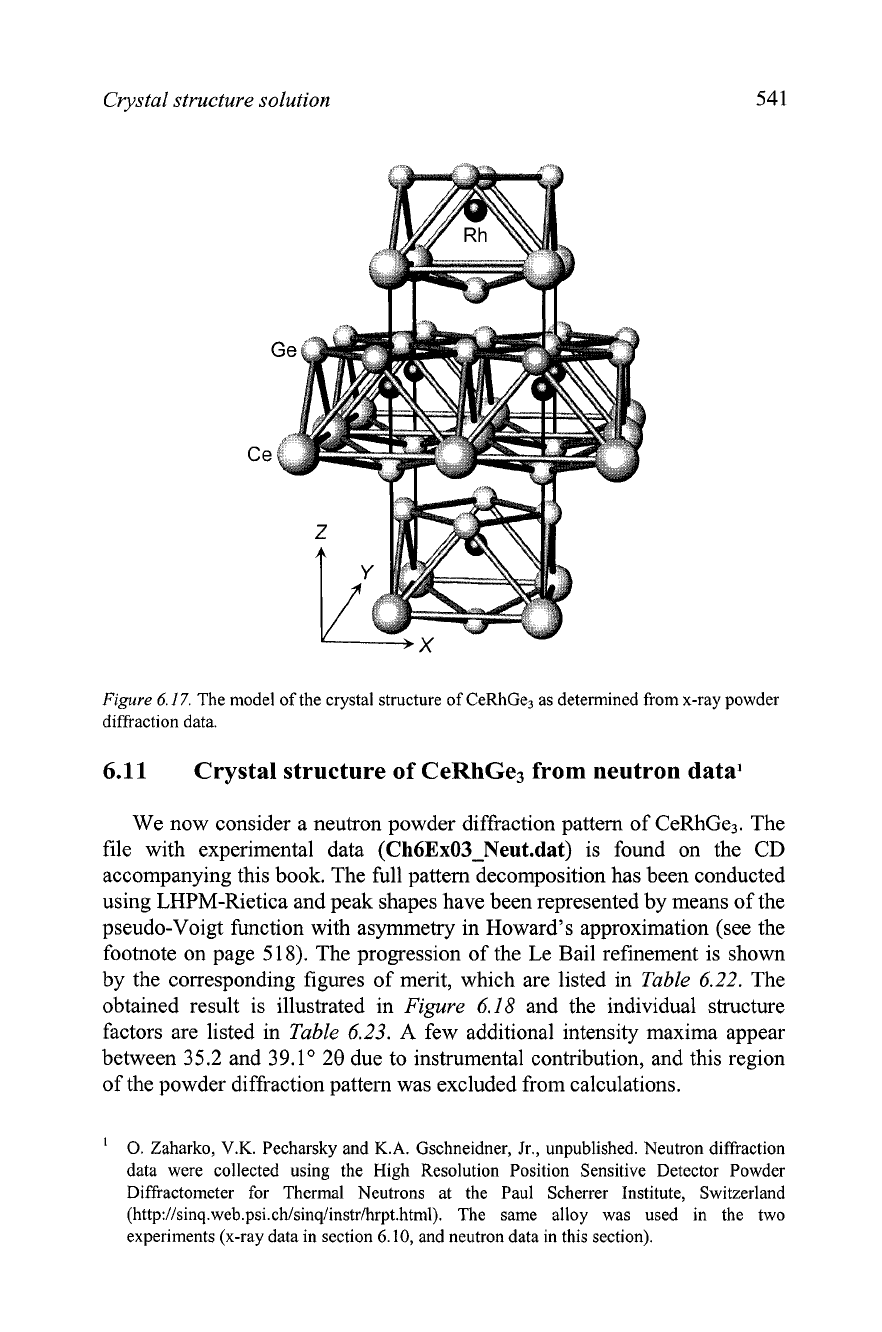
Crystal structure solution
Figure
6.17.
The model of the crystal structure of CeRhGe3 as determined from x-ray powder
diffraction data.
6.11
Crystal structure of CeRhGe3 from neutron data1
We now consider a neutron powder diffraction pattern of CeRhGe3. The
file with experimental data
(Ch6ExO3-Neut-dat)
is found on the
CD
accompanying this book. The full pattern decomposition has been conducted
using LHPM-Rietica and peak shapes have been represented by means of the
pseudo-Voigt function with asymmetry in Howard's approximation (see the
footnote on page 5
18).
The progression of the Le Bail refinement is shown
by the corresponding figures of merit, which are listed in
Table
6.22.
The
obtained result is illustrated in
Figure
6.18
and the individual structure
factors are listed in
Table
6.23.
A
few additional intensity maxima appear
between
35.2
and
39.1"
20
due to instrumental contribution, and this region
of the powder diffraction pattern was excluded from calculations.
0.
Zaharko, V.K. Pecharsky and
K.A.
Gschneidner, Jr., unpublished. Neutron diffraction
data were collected using the High Resolution Position Sensitive Detector Powder
Diffractometer for Thermal Neutrons at the Paul Scherrer Institute, Switzerland
(http://sinq.web.psi.ch/sinq/instr/hrpt.html).
The same alloy was used in the two
experiments (x-ray data in section
6.10,
and neutron data in this section).
